You are seeing this message because you are using an out-of-date browser.
Please click here for more information.
Saturn's Beautiful and Puzzling Rings
Even with a small telescope, you can easily see Saturn and it's rings. With
a medium to large sized scope, you can see that rings are not just one ring,
but there is at least one division in them.
When the Pioneer and Voyager missions visited the ringed planet, we found out
that the rings are a complex system of many individual rings, each made up of
countless pieces of ice and rock.
Saturn's Rings
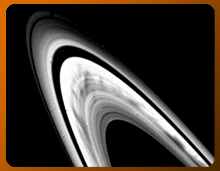
Image courtesy of: Voyager mission
Spokes in Saturn's Rings

Image courtesy of: Voyager mission
Among the many pictures the Voyager missions sent back from Saturn was this one showing what appear to be "spokes" in the giant planet's rings. What causes these spokes? How are they formed and why do they seem to appear and disappear? The answer is probably that the gravitational forces of Saturn and its moons are acting together to form the complex patterns that we see in the giant planet's rings. Whatever is causing the rings of Saturn to change the way they do, it is a very beautiful sight to see.
Hopefully the Cassini mission will help answer this question and many others we have about this beautiful planet.
The Ring Divisions
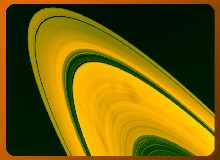
Image courtesy of: Voyager mission
The Ring Divisions

Image courtesy of: Voyager mission
Before the Voyager missions visited Saturn, we didn't know that the rings were made of up countless individual chunks of ice and rock. The rings appeared to be solid when viewing them from Earth. We did know that there were two obvious divisions in the rings that are shown in the picture at the right. The large division is known as the Cassini division, named from the French astronomer Giovanni Cassini, division and is easily seen through a medium sized telescope.
The smaller division at the top of the picture is called the Encke division, named for Johann Encke, and is visible through a large telescope.
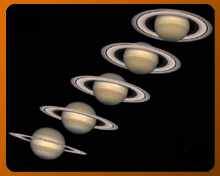
Image courtesy of: Hubble Space Telescope
Not only does the appearance of Saturn's rings change constantly, but our view of the rings from here on Earth changes as Saturn makes its way around the Sun during the twenty-nine years it takes to complete one orbit around the Sun.
Since Saturn is tilted on its on its axis, our view of the rings changes as the planet makes its way around the Sun.
This series of images that the Hubble Space telescope took from 1996 through 2000 shows how the tilt of the planets affects our view of the rings,
The pictures go from the lowest picture, taken in 1996, to the highest picture, taken in 2000. In 1996, the rings had just passed the point where they were almost edge on and as time passed, we could see more and more of the rings.
This cycle of the rings going from almost invisible to full view and back again takes about fifteen years to complete.
The Rings Disappear!
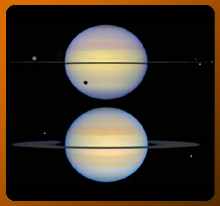
Image courtesy of: Hubble Space Telescope
Saturn's Disappearing Rings

Image courtesy of: Hubble Space Telescope
Although Saturn's rings are very wide, over 150,000 miles in diameter, they are very thin, averaging only a few hundred yards thick. The rings are not solid, but are made up of countless numbers of ice chunks and rocks usually smaller than the average pickup truck.
The thinness of Saturn's rings means that every fifteen years, we get a chance to see them almost disappear entirely, as the Hubble Space Telescope image at right, taken in the fall of 1995, shows.
You can see Saturn's moon Titan at the left in the top photograph. The dark spot that appears below the rings in the same picture is the shadow of Titan on the planet.
It's hard for us to imagine how something so large could seem to disappear entirely and then reappear and grow in size as time goes by. It's just another example of the wonders of the universe.
Saturn's Braided Ring
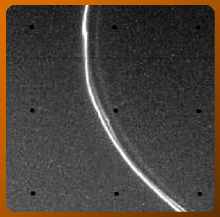
Image courtesy of: Voyager Mission
The "Braided" Ring

Image courtesy of: Voyager Mission
One of the most puzzling pictures that the Voyager mission sent back from Saturn is the one that appearsat the right.
How in the world, or universe, can a planet's ring be "braided"? This picture had scientists scratching their head for years. The theory was that a couple of tiny, undiscovered moons of Saturn were causing the braiding of the ring. It took very careful study of the Voyager pictures to find out that the braiding action is apparently being caused by the two tiny moons Pan amd Prometheus.
It's just one more mystery that scientists hope the Cassini mission will be able to solve.
Saturn's F Ring

Image courtesy of: Voyager Mission
The Biggest Mystery of the Rings

Image courtesy of: Voyager Mission
The biggest mystery of Saturn's rings, as well as the rings of the other gas planets in our solar system, is where did they some from?
Are the rings made up of material "left over" after the planet formed, or has the planet gathered up stray ice and rocks with its gravity. This is a process that we don't even begin to understand. Another possibility is that the rings are made up of the remnants of earlier moons that have been destroyed by collisions with other bodies. It is still another example of how much we have to learn about our neighborhood.
This entire site copyright © 2003 Astronomy for Kids - all rights reserved

